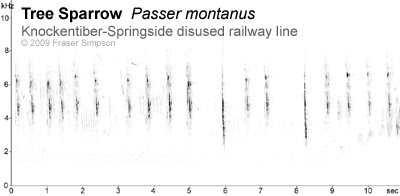Painted Ladies were active from 0704h at least and before it was time for heading back for breakfast, 32 had been counted along with 12 Orange-tips plus the other three pierids. In Kilmarnock, Painted Ladies were heading NW at a rate of 2/min around midday but on the coast between Troon and Irvine, no obvious movement was detected. Gailes Marsh had 7 and a 1.5 km stretch south from Irvine harbour mouth produced just 15.



 In the sonograms above: (1) Willow Warbler - territorial song verse (it makes a a nice looking spectrograph pattern, eh?); (2) Tree Sparrow - vocalisations uttered while perched close to the nest hole; (3) Yellowhammer - territorial song verse. A neighbouring bird consistently sang without the terminal 'cheese' phrase. Another neighbour switched between a high-pitched 'cheese' ending and a low-pitched ending, one after the other at almost a 50:50 ratio; (4) Sedge Warbler - section of a much longer delivery of territorial song from a bird low in hawthorn scrub.
In the sonograms above: (1) Willow Warbler - territorial song verse (it makes a a nice looking spectrograph pattern, eh?); (2) Tree Sparrow - vocalisations uttered while perched close to the nest hole; (3) Yellowhammer - territorial song verse. A neighbouring bird consistently sang without the terminal 'cheese' phrase. Another neighbour switched between a high-pitched 'cheese' ending and a low-pitched ending, one after the other at almost a 50:50 ratio; (4) Sedge Warbler - section of a much longer delivery of territorial song from a bird low in hawthorn scrub.
1 comment:
some great birds on your list Fraser. Dis used raiway lines always make for good habitat
Post a Comment